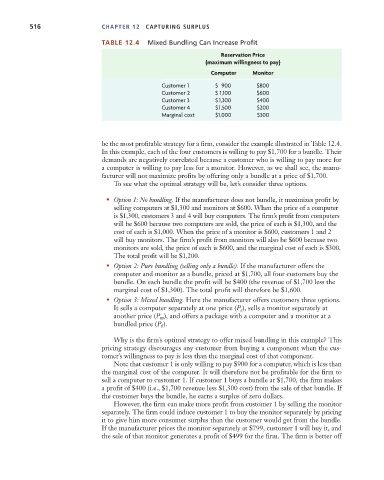Page 542 - Microeconomics, Fourth Edition
P. 542
c12capturingsurplus.qxd 7/22/10 10:41 AM Page 516
516 CHAPTER 12 CAPTURING SURPLUS
TABLE 12.4 Mixed Bundling Can Increase Profit
Reservation Price
(maximum willingness to pay)
Computer Monitor
Customer 1 $ 900 $800
Customer 2 $ 1,100 $600
Customer 3 $1,300 $400
Customer 4 $1,500 $200
Marginal cost $1,000 $300
be the most profitable strategy for a firm, consider the example illustrated in Table 12.4.
In this example, each of the four customers is willing to pay $1,700 for a bundle. Their
demands are negatively correlated because a customer who is willing to pay more for
a computer is willing to pay less for a monitor. However, as we shall see, the manu-
facturer will not maximize profits by offering only a bundle at a price of $1,700.
To see what the optimal strategy will be, let’s consider three options.
• Option 1: No bundling. If the manufacturer does not bundle, it maximizes profit by
selling computers at $1,300 and monitors at $600. When the price of a computer
is $1,300, customers 3 and 4 will buy computers. The firm’s profit from computers
will be $600 because two computers are sold, the price of each is $1,300, and the
cost of each is $1,000. When the price of a monitor is $600, customers 1 and 2
will buy monitors. The firm’s profit from monitors will also be $600 because two
monitors are sold, the price of each is $600, and the marginal cost of each is $300.
The total profit will be $1,200.
• Option 2: Pure bundling (selling only a bundle). If the manufacturer offers the
computer and monitor as a bundle, priced at $1,700, all four customers buy the
bundle. On each bundle the profit will be $400 (the revenue of $1,700 less the
marginal cost of $1,300). The total profit will therefore be $1,600.
• Option 3: Mixed bundling. Here the manufacturer offers customers three options.
It sells a computer separately at one price (P ), sells a monitor separately at
c
another price (P ), and offers a package with a computer and a monitor at a
m
bundled price (P ).
b
Why is the firm’s optimal strategy to offer mixed bundling in this example? This
pricing strategy discourages any customer from buying a component when the cus-
tomer’s willingness to pay is less than the marginal cost of that component.
Note that customer 1 is only willing to pay $900 for a computer, which is less than
the marginal cost of the computer. It will therefore not be profitable for the firm to
sell a computer to customer 1. If customer 1 buys a bundle at $1,700, the firm makes
a profit of $400 (i.e., $1,700 revenue less $1,300 cost) from the sale of that bundle. If
the customer buys the bundle, he earns a surplus of zero dollars.
However, the firm can make more profit from customer 1 by selling the monitor
separately. The firm could induce customer 1 to buy the monitor separately by pricing
it to give him more consumer surplus than the customer would get from the bundle.
If the manufacturer prices the monitor separately at $799, customer 1 will buy it, and
the sale of that monitor generates a profit of $499 for the firm. The firm is better off

